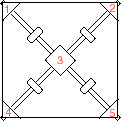
Rice Paper
Contact
Home

Rice Paper Kite
It is almost certain that kite originated in China around 200 B.C. and spread rapidly throughout Asia. Traditional Chinese kites were covered with paper or silk. The use of rice paper as covering material has a very respectable history in this craft. The paper is light, easy to work with, inexpensive, can be very strong and decorated in many ways.
Equipment- Bamboo spars
- Rice paper
- Glue
- Thread
- Lines
- Frame. The Chinese framing materials for kite have remained the same to this day: bamboo. Bamboo is extremely light and flexible and very easy to work with. Make frame pieces from the same nodal part of bamboo. If it is a 20 inches kite, make spars 3/16 inch in thickness. Tie two spars of same length together by thread with bamboo skin facing the same side. This will be the face of kite, facing the wind.

- Sail. Glue the paper over the face of kite. At the back of kite, glue reinforcement paper tabs. And paint the face of kite as desired. Many rice paper can be used as kite covering, but bear in mind the size of a kite when choosing paper. A thin paper on a large kite may not be durable under wind pressure. The paper may be torn by wind. Conversely, heavy paper might weigh down a small kite unnecessarily.

- Bridle line. Burn two holes by incense beside spars at corners and center of the kite. Use these holes as the attachment points for kite bridle and tail. Tie bridle line at point 1 and 2 and flying line at point 3. Then tie a knot at towing point.

- Tail. Tie tail line at back of the kite at point 4 and 5. Make the fork 1.5 - 2 times of the kite and tail 5 times of the fork. Attach paper tassels.

| Rice Paper |
|
About History Fiber Production Make Your Own Sizing |
| Uses |
|
Calligraphy Mounting Painting Relief Printing Rubbing Western Art Kite Paper Cut Lantern Surfboard Window Covering |